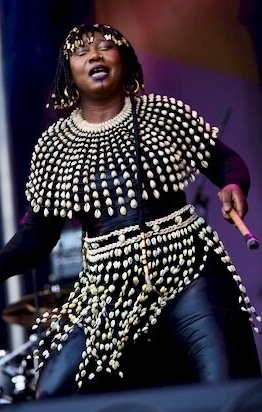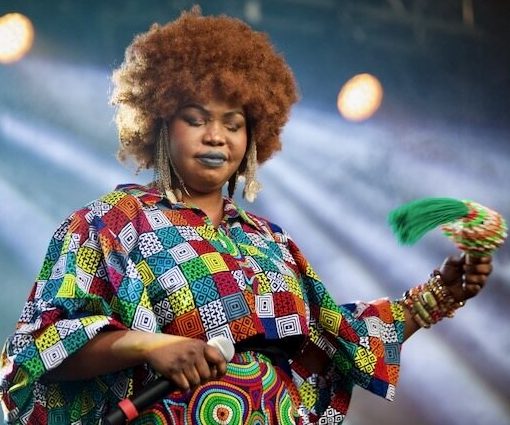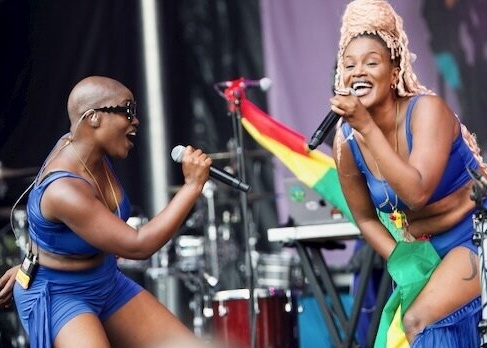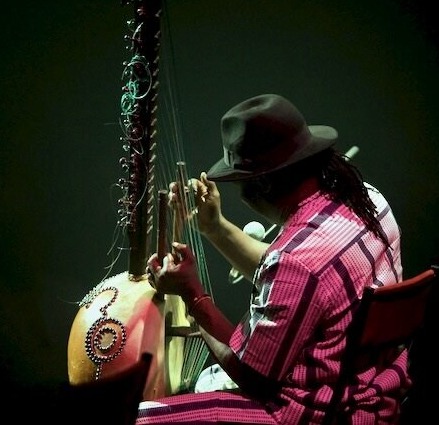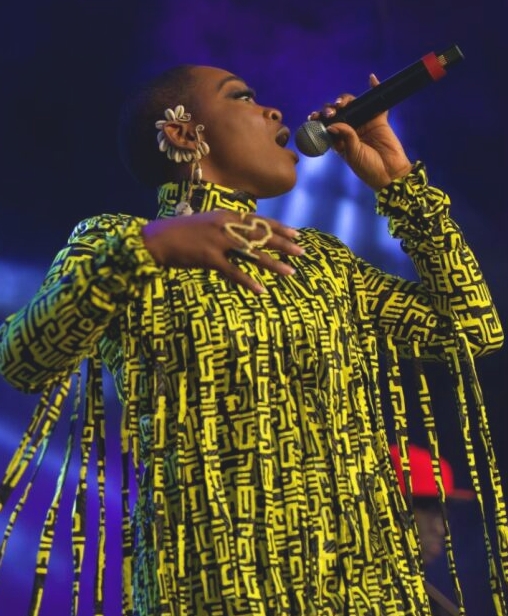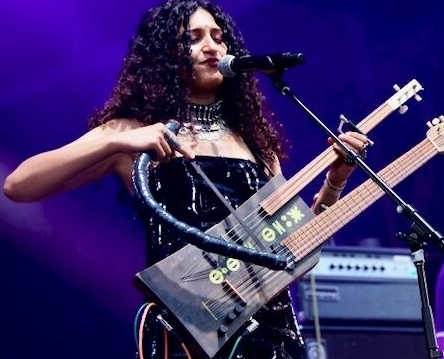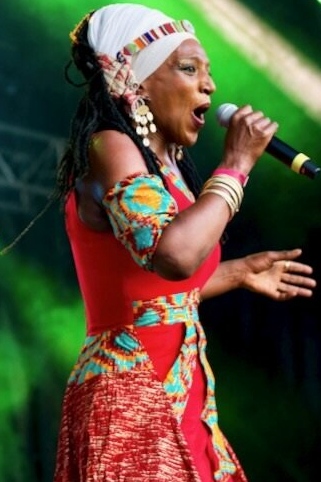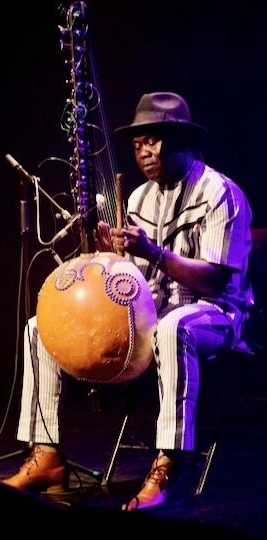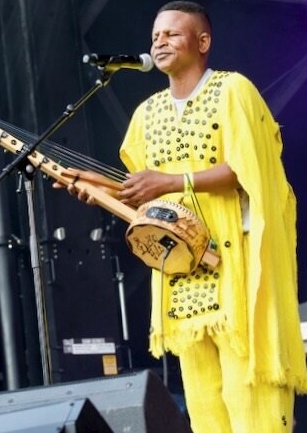This
year's 39th edition of Les Nuits promised to be the big
one before the Big Bang: next year's 40th anniversary. It
featured 120 concerts: 13 days of indoor programming with
the last six days dedicated to free shows that ran from
the early afternoon until  the
midnight hour at Place des Spectacles, in the heart of Montreal’s
cultural center.
the
midnight hour at Place des Spectacles, in the heart of Montreal’s
cultural center.
As a platform
for both music and culture, where past, present and future
converge in the magic of performance, Montreal’s 13-day
Les Nuits d’Afrique Music Festival is unparalleled
in the Americas, in part due to the astute programming of
Sepopo Galley and her team and the city’s welcoming
attitude to diasporic Africans who have cultivated enthusiastic
audiences for the incredible variety of music they introduce
to the city and beyond. 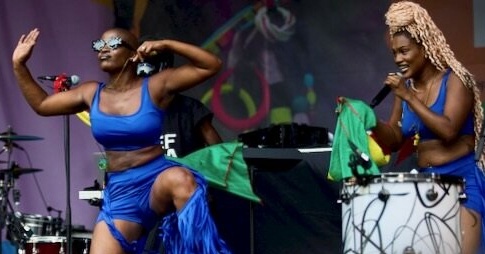
The concept
of fusion of different musics is, as an encyclopaedic entry,
typically attributed to jazz in the late 1960s, in reference
to Miles Davis, John McLaughlin and Weather Report when
they began to incorporate rock into the jazz idiom. However,
and in unacknowledged point of fact, the roots of fusion
go back to the 15th century, with the transatlantic slave
trade. When Africans were forcibly transported by the tens
of thousands to the Americas, it had an unintended but profound
cultural effect: every nation that sanctioned the importation
of slaves witnessed its music grow and evolve and eventually
inform all the world’s musical genres. There would
be no Brazilian or Cuban sound without Africa.
From its humble
beginnings to the present, Les Nuits continually dedicates
itself to the retelling, through music, of this remarkable
historical odyssey , at once tragic and cathartic. In what
can only be described as the mother of all ironies, the
importing nations profited not only from centuries of free
labour but saw their cultures unprecedentedly enriched.
In today's more tolerant climate, what was once a 'win-win'
for the abusing country is now a 'win' for the world's music,
with Montreal serving as the focal point for the Americas.
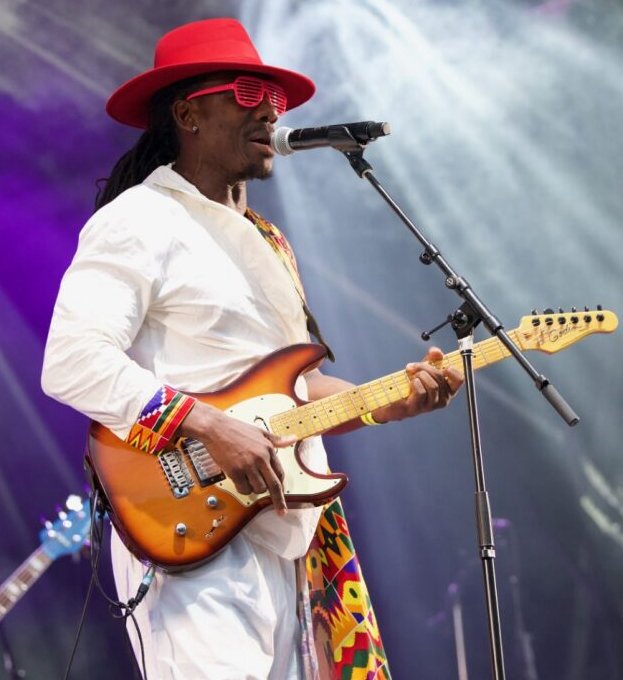 Afrobeat,
sometimes called Afrofunk, is the current that runs through
the festival’s entire line-up of music. As a fusionable
music, it is without equal and represents one of the most
enduring fusions in the history of music. In 2022 Afrobeat
(according to Spotify) registered an astounding 13
billion streams. There would be no James
Brown without the influence of Nigeria’s Fela Kutu;
and in respect to its polyrhythms and contrapuntal bass
lines, there would be no reggae or hip-hop. For a quick
immersion in Afrobeat and its impact and influence, there
is no better place to begin than with Les Nuits d’Afrique
festival.
Afrobeat,
sometimes called Afrofunk, is the current that runs through
the festival’s entire line-up of music. As a fusionable
music, it is without equal and represents one of the most
enduring fusions in the history of music. In 2022 Afrobeat
(according to Spotify) registered an astounding 13
billion streams. There would be no James
Brown without the influence of Nigeria’s Fela Kutu;
and in respect to its polyrhythms and contrapuntal bass
lines, there would be no reggae or hip-hop. For a quick
immersion in Afrobeat and its impact and influence, there
is no better place to begin than with Les Nuits d’Afrique
festival.
Among the many
vibrant venues of the festival, none is as important as
the city’s legendary Club Balattou. For 35 years this
iconic establishment has served as a crucial launching pad
for countless musicians by fostering a dynamic environment.
Club owner and festival founder Laminé Toure says
it has been the privilege of a lifetime in his role as an
enabler in the continuous cross-pollination of the world’s
diverse musical traditions.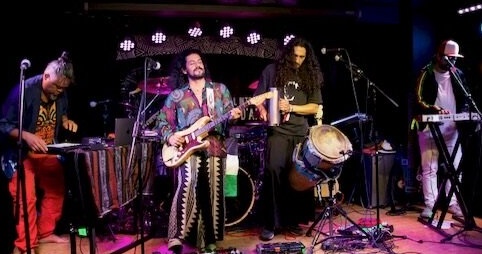
As per tradition,
the festival kicked off at the storied club with a captivating
performance by the Columbian-Belgian group La Chiva Gantiva.
Their foreboding sound, heavily driven by percussion, dedicates
itself to the plaintive and portentous variations on the
theme of apocalype. On the emotive scale, the music vacillates
from cries in the night to a persistent wailing sound, the
perfect soundtrack for a species that has brought itself
to the edge of the abyss. Which isn't to say the music wasn't
friendly to whatever contortions one might bring to the
dance floor. Built on a single, drone-like harmonic, their
music creates its effects through a conjunction of uncomplicated
melody, dissonant vocals and a counter-intuitve rhythm section.
Theirs isn’t so much a message in the bottle as an
explosion of light in dark times; a powerful reminder that
in every pessimistic music there is a transcendental interval.
Transmuting the confusion of the world into the sound and
fury of life is La Chiva’s supreme accomplishment.
In a similar
vein, Syrian-French ensemble Sarab combined the traditional
Arab sound and its persistently tragic scale with techno-electric
dynamics with one aim in mind: frenzy, catharsis. Singer,
song writer Climene Zarkan wields her powerful voice 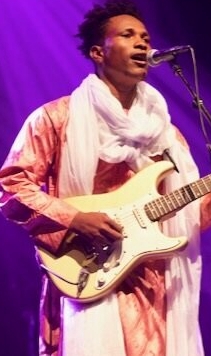 with
the precision of a glass cutter. From one moment to the
next it can be a thing of beauty or turned into a bullet.
But either way, it transports the listener to a better world
than the one he/she presently inhabits.
with
the precision of a glass cutter. From one moment to the
next it can be a thing of beauty or turned into a bullet.
But either way, it transports the listener to a better world
than the one he/she presently inhabits.
Of Toureg/Berber
descent, Boubé’s heartfelt music begins in
the hard scrabble life on the desert’s edge where
even camels fear to tread. His music is a rite of initiation
that culminates in the present century, articulated by compelling
guitar work, the notes of which initially disappear as they
are played, as if blown away by a desert wind, but gradually
becoming more pedal-sustained and acidic (think Hendrix),
as if the music’s mode of transport had been imperceptibly
switched from dromedary to a digital device. Boubé
proved to be one of the festival’s pleasant discoveries
but it remas to be seen if the music can withstand repeated
listening.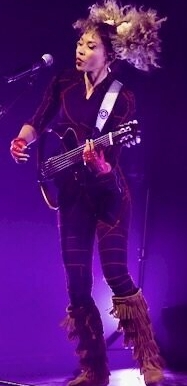
When Brazil’s
Flavia Coelho landed on the stage for the festival's main
event, more kinetic energy than flesh, it was as if she
had spent the first part of her day attached to a particle
accelerator. With her music serving as launching pad for
her boundless energy and enthusiasm, before disbelieving
eyes, she effortlessly defied the laws of physics, appearing
to occupy multiple spaces simultaneously. While not as young
as she used to be (I last saw her eight years ago), her
repertoire, paradoxically, has grown younger, with the introduction
of Brazilian rap into her bouncy playlist. In the spirit
of the positive passage of time, the most promising change
in Coelho's musicianship comes by way of hers voice: now
richer and more resonant. I can only hope that she’ll
find a music that does her voice proud, which might mean
slowing down a bit and dispensing with the eye-distracting
aerobics. We want to know makes her heart flutter rather
than witness her gymnastic dexterity.
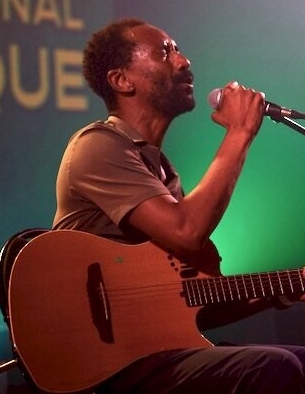 Guitarist
singer Daby Touré , when joined by his band, which
included a gifted conga/percussionist, produced one of the
best grooves of the festival. He was able to float his audience
that swayed more than hopped or rocked, and the music was
such that everyone wanted whatever song he was playing to
continue.
Guitarist
singer Daby Touré , when joined by his band, which
included a gifted conga/percussionist, produced one of the
best grooves of the festival. He was able to float his audience
that swayed more than hopped or rocked, and the music was
such that everyone wanted whatever song he was playing to
continue.
The ‘night
of the kora’ (Nuit de la Kora) proved to be a night
to be remembered. Zal Sissokho, who opened the evening,
introduced the headliner as a master of the instrument,
and without exaggerating, that might have been a understatement.
It is truly perplexing that Toumany Kouyaté is scarcely
mentioned online and is not widely recognized among the
world’s top five kora players, especially given his
four decades of international performance; an oversight
that is nothing short of baffling, mystifying, and stark
reminder that life isn't always fair. Whether it’s
a marketing blunder of spectacular magnitude or a collective
failure of the our most discerning music critics remains
anyone’s worst guess. Yet, within moments of his performance,
Kouyaté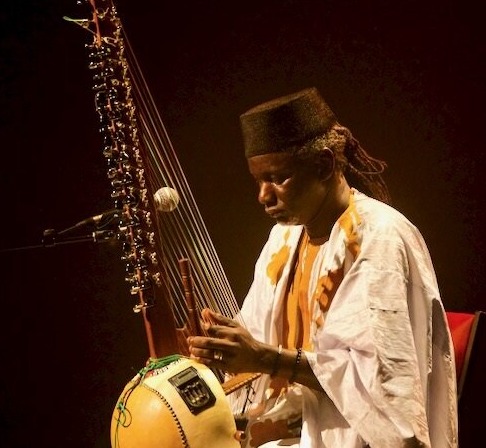 unequivocally demonstrated his world-class talent.
unequivocally demonstrated his world-class talent.
To begin with,
his technique is impeccable, as is the limpidity of his
playing which is nothing less than awesome given the speed
of his runs. But it’s his conceptual approach and
relentless invention that distinguishes his playing. Through
the rapid repetition of a select few strings, he masterfully
rises to the occasion of singularity on his instrument as
well as inducing trance-like states. At times, he aggressively
attacks his strings, producing grating sounds that almost
mimic the deliberately amp-distorted forays into the rock
idiom. Conversely, he can waft his fingers over the strings
with the delicate touch of a feather floating on a summer
breeze; and his unique choice of strings allows him to play
in keys that, in theory, the fixed position of the kora’s
21 strings should not permit. If one of the general complaints
of the kora is that its advocates, unlike the guitarists,
don’t experiment with different tunings, it’s
because they choose to remain true to the tradition. That
said, the tradition is being creatively challenged by artists
such as Sona Jobarteh and the Moroccan group Zar Electric.
Nevertheless, Kouyaté distinguishes himself by producing
a unique sound and feel, a testament to his brilliance and
ability to make the kora correspond to his inner visions.
If there’s an event that embodies the essence of Les
Nuits d’Afrique both as music and cultural festival,
it is undoubtedly rooted in the kora, an instrument that
has weathered the vicissitudes of time through the universal
language of music.
In interview
with Rich Beato, Sting explains that for music to sustain
his interest "it must surprise" him. He surely
speaks on behalf of the legions of jaded listeners, especially
the older generation that has heard and seen it all. By
that standard, Bab L’ 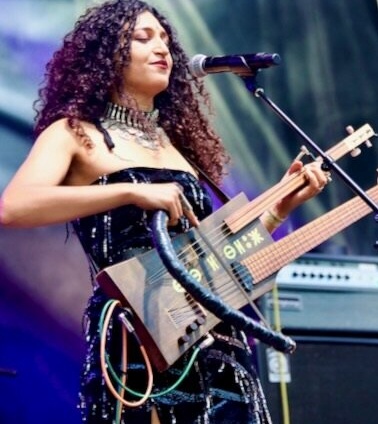 Bluz,
transplanted from Marrakesh to Paris, delivered the goods
and much more. To begin with, mention must be made of their
tantalizing time signatures, which gave all of their music
and edge and unique point of departure. While the Arabic
scale underpins their general sound, it is masterfully co-opted
and revamped into progressive rock, culminating in sustained,
ecstatic intervals.
Bluz,
transplanted from Marrakesh to Paris, delivered the goods
and much more. To begin with, mention must be made of their
tantalizing time signatures, which gave all of their music
and edge and unique point of departure. While the Arabic
scale underpins their general sound, it is masterfully co-opted
and revamped into progressive rock, culminating in sustained,
ecstatic intervals.
Bab L’
Bluz has successfully carved out a very particularized niche
sound and is deservedly gaining international recognition.
The group is led by the dynamic and enchanting Yousra Mansour,
who plays a double necked guitar (guembri), who on stage
is all sound and frenzy, which is contagious. Of equal importance
to the group dynamic is the musicianship of Brice Bottin,
whose incomparable contrapuntal bass is the force field
that drives the music that thrives on irreverence and refuses
to recognize borders. Their performance was, without doubt,
a festival highlight.
Supplying the
festival deficit of pure melody was the group Les Mamans
du Congo X Rrobin, whose only shortcoming is their unwieldy
name. Among their many offerings, and on several occasions,
they dared to slow down the tempo to ballad speed, refusing
to be held hostage by the pervasive, conga-driven frenzy
that characterizes much of the festival’s playlist.
Their frequent harmonies were an unexpected treat, and their
incantatory rhythms and hip-hop were met with wild approval.
By my ear, they richly deserve a spot on the main stage
for next year’s 40th.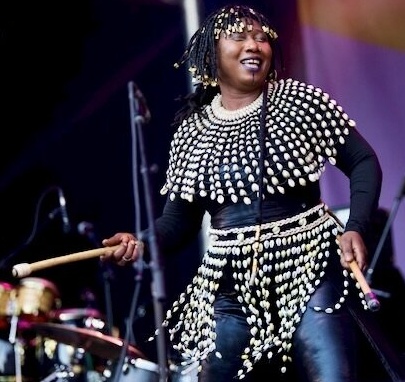
I first caught
the breathtakingly talanted, award-winning Djely Tapa during
her breakout year in 2019. I described her voice as follows:
“Blessed with a voice that can burn-dry a lake under
a monsoon sky, its ear-pleasing purity and specific gravity
are such that it keeps all other instruments and listeners
in mesmerizing thrall.” I’m happy to report
that six years later, her voice is even better: perhaps
a touch lower in the register, but now richer, smoother,
and more compelling,. And despite her physical gesticulations,
she is in total control of her extended 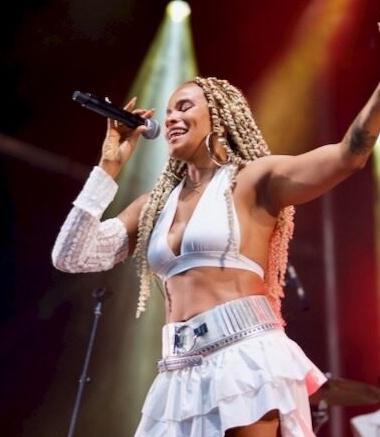 vocal
range even as her body is transformed into the privileged
site music requires for its pure expression. Her current
repertoire seems to draw less from traditional Malian influences
and more from her inner self, her soul, culminating in a
continuous celebration of music’s power and the sheer
joy of being alive in the present.
vocal
range even as her body is transformed into the privileged
site music requires for its pure expression. Her current
repertoire seems to draw less from traditional Malian influences
and more from her inner self, her soul, culminating in a
continuous celebration of music’s power and the sheer
joy of being alive in the present.
For listeners,
who like myself, are drawn to vocal harmony like heliotropes
turn to the sun, there wasn’t much on the menu until
the last day. Supplying the harmony deficit in spades was
hip-hop influenced Bic Tizon Dife and the amazing Las Karambas,
the latter comprised of six, musically trained Latino women
whose original material was spiced up with a variety of
time signatures and a stage presence that combined an infectious
ebullience and energy that everyone immediately connected
to. Bring them back for next year.
* * * * * * * * * * * *
With its vibrant
ateliers, diverse ethnic foods, and an incredible array
of colors and traditional attire, culminating in the fascinating
and eclectic Timbuktu Market place, Les Nuits d’Afrique
serves as both an invitation to self-discovery and is a
life-sized window into a brighter future — a more
tolerant and egalitarian world, which implicitly places
the onus on us, the festival goers, to convert the enriching
cultural experience into lessons learned so that we can
integrate them into our daily life.
As a festival
that renews itself every year with resounding vigour and
invention, Les Nuits consistently sets the tone and raises
bar on what is possible; and for this, kudos to the organizers,
who as usual didn’t miss a beat.
And happily,
the beat goes on.
Stay tuned for
the big 40th in 2026.
FESTIVAL PHOTOS
PHOTOS
©
JERRY PRINDLE
